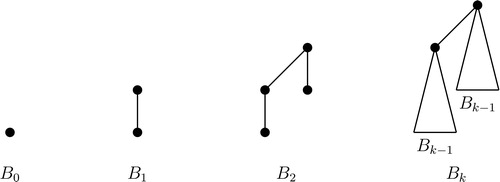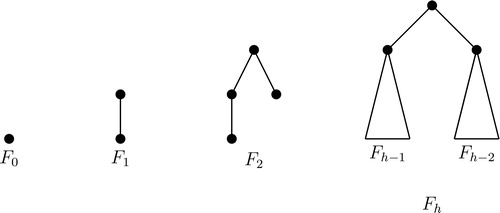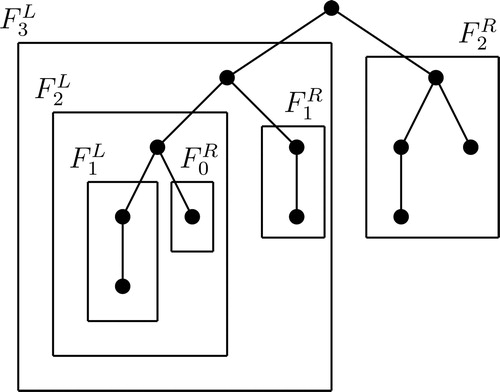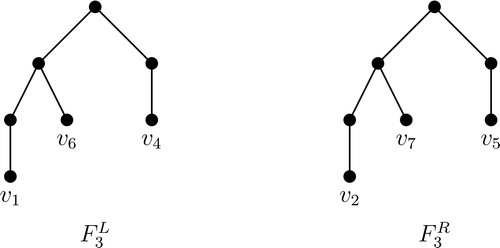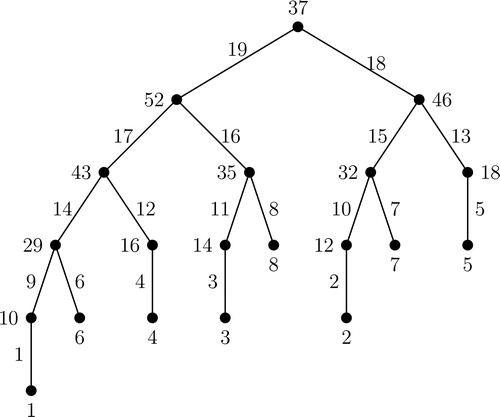 ?Mathematical formulae have been encoded as MathML and are displayed in this HTML version using MathJax in order to improve their display. Uncheck the box to turn MathJax off. This feature requires Javascript. Click on a formula to zoom.
?Mathematical formulae have been encoded as MathML and are displayed in this HTML version using MathJax in order to improve their display. Uncheck the box to turn MathJax off. This feature requires Javascript. Click on a formula to zoom.Abstract
An antimagic labeling of a graph G with q edges is an injective mapping such that the induced vertex label for each vertex is different, where the induced vertex label of a vertex u is
Here, E(u) is the set of edges incident to the vertex u. In 1990, Hartsfield and Ringel conjectured that all trees except K2 are antimagic. Still this conjecture is open. In this article, we prove that two recursive classes of trees called binomial tree Bk,
and Fibonacci tree Fh,
are antimagic. This result supports Hartsfield and Ringel conjecture.
MATHEMATICS SUBJECT CLASSIFICATION:
1. Introduction
Hartsfield and Ringel [Citation3] introduced antimagic labeling. Let be a simple graph without any isolated vertex and
is a bijective mapping. For each vertex u of G, the vertex sum
where E(u) is the set of edges incident to u. If
for any two distinct vertices
then f is called antimagic labeling of G. A graph is called antimagic if it admits antimagic labeling. In 1990, Hartsfield and Ringel [Citation3] conjectured that every tree except K2 is antimagic. This conjecture is still open for over three decades now. Though several partial results supporting Hartsfield and Ringel conjecture have been proved, completely settling the conjecture appears to be hard.
Hartsfield and Ringel [Citation3] proved that paths are antimagic. Shang [Citation6] has proved that all spiders are antimagic. Chawathe and Krishna [Citation1] proved that complete m-ary trees are antimagic. Kaplan et al. [Citation4] showed that trees with at most one 2-degree vertex are antimagic. Recently, in 2014, Liang et al. [Citation5] interestingly identified the class of trees with structural property admitting antimagic labeling. More precisely, Liang et al. [Citation5] proved that if T is a tree with either and
are both independent sets or
induces a path and every other vertex of T has an odd degree, then T is antimagic, where
is set of 2-degree vertices of the tree T. This result motivated us to identify the family of trees having the complementary structural property of the trees considered by Liang et al. [Citation5]. That is, if
denotes the set of all 2-degree vertices of a tree T, then neither
and
are both independent sets nor
induces a path and every other vertex has an odd degree. In this article, we identify two new families of trees called binomial trees and Fibonacci trees satisfying the above complementary property.
The binomial tree Bk is a rooted tree defined recursively. The binomial tree B0 is a single node and B1 is an edge. One of the pendent vertices of B1 is considered as the root of B1. The binomial tree Bk consists of two binomial trees that are linked together so that the root of one is the leftmost child of the root of the other. The root of the right copy of
is the root of Bk (in , the binomial trees B0, B1, B2, and Bk are given).
The Fibonacci tree Fh is a rooted tree of height h defined recursively. The Fibonacci tree F0 is a single node and F1 is an edge K2. The Fibonacci tree F2 is constructed by taking a copy of F1; a copy of F0; a new vertex considering it as the root of F2 and making it adjacent to a vertex of F1 and a vertex of F0. For the Fibonacci tree Fh is constructed by taking a copy of
a copy of
a new vertex considering it as the root of Fh and making it adjacent to the root vertex of
and the root vertex of
(in , the Fibonacci trees F0, F1, F2, and Fh are given).
Furthermore, in this article, we prove that binomial tree Bk, for all and Fibonacci tree Fh, for all
are antimagic. These two results support Hartsfield and Ringel conjecture [Citation3].
2. Binomial trees are antimagic
In this section, we prove that binomial trees are antimagic. As binomial tree B0 is a single node and binomial tree B1 is a K2, B0 and B1 are not antimagic. In Theorem 1, we prove that all binomial trees Bk, are antimagic.
Theorem 1.
The binomial tree Bk, for is antimagic.
Proof.
Consider the binomial tree Bk. The binomial tree Bk is basically a rooted tree of height k having vertices. There are exactly kCi vertices at level i, for
The binomial tree Bk has exactly
vertices of degree i, for
and exactly 2 vertices of degree k. We give the antimagic labeling of the binomial tree Bk, for
using the following two steps.
Step 1: Linear representation of the binomial tree
Let
and
be the two copies of
in Bk, called the left subtree and right subtree. Let
Arrange
into two rows. The top row consists of vertices
from right to left. The bottom row consists of vertices
from right to left.
Let ei be the edge joining vi and
where
The edges e1, e2,
are called vertical edges. Let
be the edge joining
and
where
The edges
are called horizontal edges.
For
and
let
be the edge joining
and
The edges are called the right to left link edges.
Label the corresponding vertices and edges of
as in
where the vertex vi is replaced by
for
and the edge ei is replaced by
for
Let
denote the edge joining the root
of
and the root
of
in Bk (The representation of vertices and edges of B4 is shown in ).
Step 2: Defining antimagic labeling
Consider the binomial tree
with its linear representation as described in Step 1. Define a function
such that
for i,
and
Clearly, f is a bijection.
Claim: Induced vertex labels are distinct.
The induced vertex label is defined to be the sum of the labels of the edges incident with the vertex. Under the linear representation of binomial tree Bk, Bk has vertices
each having degree one. For
the set of edges incident with the vertex vi,
and with the vertex
Bk has vertices
each having degree two. For
the set of edges incident with the vertex
and the set of edges incident with the vertex
Bk has vertices
each having degree j, where
For
and
the set of edges incident with the vertex
and with the vertex
Bk has two vertices and
each having degree k. The set of edges incident with the vertex
and with the vertex
The induced vertex label of vi is where
For the induced vertex label of one degree vertex
and
From the definition of f, it is clear that,
(1)
(1)
For the induced vertex label of two degree vertex
and
From the definition of f, it follows that
(2)
(2)
For and
the induced vertex label of j degree vertex,
From the definition of f, it follows that
(3)
(3)
The induced vertex label of k degree vertices and
By the definition of f, it is clear that
(4)
(4)
Therefore, from EquationEquations (1)(1)
(1) to Equation(4)
(4)
(4) it is clear that, for
the induced vertex labels of all j degree vertices are distinct.
From (Equation1(1)
(1) ) and (Equation2
(2)
(2) ), the maximum of one degree vertex label induced is
and the minimum of two degree vertex label induced is
By the definition of f,
Hence,
(5)
(5)
From (Equation2(2)
(2) ) and (Equation3
(3)
(3) ), the maximum of two degree vertex label induced is
and the minimum of three degree vertex label induced is
By the definition of f,
and
Hence,
(6)
(6)
From (Equation3(3)
(3) ), for
the maximum of j degree vertex label induced is
and the minimum of j + 1 degree vertex label induced is
By the definition of f,
Hence, for any
(7)
(7)
From (Equation3(3)
(3) ) and (Equation4
(4)
(4) ), the maximum of k – 1 degree vertex label induced is
and the minimum of k degree vertex label induced is
By the definition of f, we have,
Hence,
(8)
(8)
From EquationEquations (5)(5)
(5) to Equation(8)
(8)
(8) , we observe that, the minimum of the induced vertex labels of j degree vertex is greater than the maximum of the induced vertex label of j – 1 degree vertex, for
From EquationEquations (1)
(1)
(1) to Equation(4)
(4)
(4) , for
the induced vertex labels of all j degree vertices are distinct.
Thus, all the induced vertex labels of Bk are distinct. Hence, the function is injective.
From Step 2, it is clear that the function f defined in Step 2 is antimagic. Thus, the binomial tree Bk, for is antimagic. □
In , the edge labels and the induced vertex labels of B4 are shown as an illustration.
3. Fibonacci trees are antimagic
In this section, we prove that Fibonacci trees are antimagic. As Fibonacci tree F0 is a single node and Fibonacci tree F1 is K2, F0 and F1 are not antimagic. In Theorem 2, we prove that Fibonacci tree Fh is antimagic, for
Theorem 2.
The Fibonacci tree Fh, for is antimagic.
Proof.
Consider the Fibonacci tree Fh. Let n(h) denote the number of vertices in Fibonacci tree Fh. Observe that, Fh consists of vertices of degree either one or two or three. Let denote the number of i degree vertices in Fh, for
In Fibonacci tree F2,
and in F3,
From the definition of Fibonacci tree Fh, we have, for
+
and
Now we give the antimagic labeling of the Fibonacci tree Fh, for
using the following two steps.
Step 1: Representation of Fibonacci tree
For the convenience of naming the vertices, we visualize the Fibonacci tree as given below.
In Fh, the left subtree is referred to as
and the right subtree
is referred to as
In general, in Fh, for j,
the left subtree of
is referred as
and the right subtree of
is referred as
(The representation of the left and right subtrees of F4 are shown in ).
Observe that, in any Fibonacci tree Fh, for j, the pendant vertices of
are the pendant vertices of
and the pendant vertices of
We name the vertices and the edges of Fh using the following vertex and edge naming procedure.
Vertex and edge naming procedure:
In F2, name the unique pendant vertex in
as v1 and name the unique pendant vertex in
as v2. In F3, name the pendant vertex in
as v1 and name the pendant vertex in
as v3. Then, name the pendant vertex in
as v2.
In Fh, for
name the pendant vertex in
as v1 and in
as
Then, name the pendant vertex in
as
For each j,
in the increasing order of j, we name the pendant vertices of
and
recursively as given below.
For each j,
consider the left subtree
and its corresponding right subtree
By the representation of subtrees of Fibonacci tree, the pendant vertices of
are the pendant vertices of
and the pendant vertices of
Since all the pendant vertices of
and
are already named, it implies that all the pendant vertices of
are also named. Thus for each pendant vertex in
if it is named as vl in
then find its corresponding pendant vertex in
and name it as
Then, consider the left subtree
and its corresponding right subtree
For each pendant vertex in
if it is named as vl in
then find its corresponding pendant vertex in
and name it as
Observe that, the pendant vertices of the left subtree
are the pendant vertices of
and the pendant vertices of
Since all the pendant vertices of
and
are already named, it implies that all the pendant vertices of
are also named.
In Fh, name the parent vertex of v1 as
Then, find the vertex vk with least suffix k such that the parent of vk is not named. Now name the parent of vk as
where vy is the latest named parent vertex. Continue this process until we finally name the root vertex of Fh.
Now, after naming all the vertices in Fh, the pendant vertices can be arranged as a sequence v1, v2,
where
is the number of one-degree vertices in Fh; the two-degree vertices in Fh can be arranged as a sequence
and
and the three-degree vertices in Fh can be arranged as a sequence
For
the edge (vi, vj) is named as ei.
(The naming of the pendant vertices of F5 is shown in step by step manner in and . The above description of vertices and edges of the Fibonacci tree F5 are shown in .)
Step 2: Defining antimagic labeling
Consider the Fibonacci tree Fh as described in Step 1. Define a function such that
for i,
Clearly, f is a bijection.
Claim: Induced vertex labels are distinct.
Under the representation of the Fibonacci tree, Fh, Fh has vertices
each having degree one. For
the set of edges incident with the vertex vi,
Fh has vertices
and
each having degree 2. For
the set of edges incident with the vertex
and with the vertex
Fh has vertices
each having degree 3. For
the set of edges incident with the vertex
For
the set of edges incident with the vertex
For
and
the set of edges incident with the vertex
The induced vertex label of vi, for
For
the induced vertex label of one degree vertex
From the definition of f, we can see that
(1)
(1)
For the induced vertex label of two degree vertex
and
From the definition of f, we can see that
(2)
(2)
For the induced vertex label of three degree vertex
and for
In general, for
where
. From the definition of f, it is follows that
(3)
(3)
Therefore, from EquationEquations (1)(1)
(1) to Equation(3)
(3)
(3) it is clear that, for
the induced vertex labels of all j degree vertices are distinct.
Also, from the definition of f, we have,
for
(4)
That is, the difference between any two vertices of degree three is at least 3.
From (Equation1(1)
(1) ) and (Equation2
(2)
(2) ), the maximum of one degree vertex label induced is
and the minimum of two degree vertex label induced is
As
we have,
(5)
(5)
From (Equation2(2)
(2) ) and (Equation3
(3)
(3) ), the maximum of two degree vertex label induced is
and the minimum of three degree vertex label induced is
From the definition of f,
and
Hence,
(6)
(6)
From EquationEquations (1)(1)
(1) to Equation(6)
(6)
(6) , we have,
Hence, the induced vertex labels of all the vertices of Fh are ordered and are distinct except the root vertex
For the base case h < 5, it is easy to verify that for any
For
Hence,
for any
Hence, for
all the induced vertex labels of Fh are distinct. For
we observe that,
If
for any
then all the induced vertex labels of Fh are distinct.
Suppose, if for some i,
then we define a relabeling function
such that
for i,
Clearly
is a bijection.
The induced vertex labels are given by where
By the definition of
we have,
for
and
and
From the definition of the induced vertex labels of one degree and two degree vertices are all distinct. From (Equation4
(4)
(4) ), we have,
and
Hence, the induced vertex labels of three degree vertices are distinct and the root vertex label do not coincide with any of the other induced vertex labels.
Therefore, all the induced vertex labels of Fh are distinct.
Hence from Step 2, it is clear that the function defined in Step 2 is antimagic. Hence the Fibonacci tree Fh, for is antimagic. □
In , antimagic labeling of F5 is shown as an illustration.
4. Discussion
It appears that recursively defined trees (like binomial trees and Fibonacci trees) favors for defining antimagic labeling. Thus, we end the article with the following question.
What are the other well-defined recursive classes of trees having the complementary structural property of the trees considered by Liang et al. [Citation5] that admit antimagic labeling?
Acknowledgment
The authors profoundly thank both the anonymous referees for their valuable comments in improving the presentation of the paper.
Additional information
Funding
References
- Chawathe, P. D, Krishna, V. (2002). Antimagic labelings of complete m-ary trees. In: Agarwal, A. K., Berndt, B. C., Krattenthaler, C. F., Mullen, G. L., Ramachandra, K., Waldschmidt, M., eds. Number Theory and Discrete Mathematics. Basel: Birkhäuser, pp. 77–80.
- Gallian, J. (2019). A dynamic survey of graph labeling. Electron. J. Comb. DS6: 1–533.
- Hartsfield, N, Ringel, G. (1990). Pearls in Graph Theory. Boston, MA: Academic Press.
- Kaplan, G., Lev, A, Roditty, Y. (2009). On zero-sum partitions and anti-magic trees. Discrete Math. 309(8): 2010–2014.
- Liang, Y. C., Wong, T. L, Zhu, X. (2014). Antimagic labeling of trees. Discrete Math. 331: 9–14.
- Shang, J. L. (2015). Spiders are antimagic. Ars Comb. 118: 367–372.

